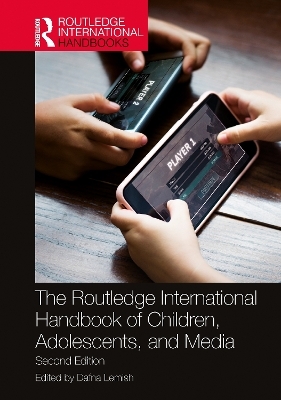
The Routledge International Handbook of Children, Adolescents, and Media
Routledge (Verlag)
978-0-367-63338-7 (ISBN)
The roles that media play in the lives of children and adolescents, as well as their potential implications for their cognitive, emotional, social, and behavioral development, have attracted growing research attention in a variety of disciplines. This handbook presents a collection that spans a variety of disciplines including developmental psychology, media studies, public health, education, feminist studies, and the sociology of childhood. Chapters provide a unique intellectual mapping of current knowledge, exploring the relationship between children and media in local, national, and global contexts.
Divided into five parts, each with an introduction explaining the themes and topics covered, the Handbook features over 50 contributions from leading and upcoming academics from around the globe. The revised and new chapters consider vital questions by analyzing texts, audience, and institutions, including:
media and its effects on children’s mental health
children and the internet of toys
media and digital inequalities
news and citizenship in the aftermath of COVID-19
The Handbook’s interdisciplinary approach and comprehensive, current, and international scope make it an authoritative, state-of-the-art guide to the field of children’s media studies. It will be indispensable for media scholars and professionals, policy makers, educators, and parents.
Dafna Lemish is a Distinguished Professor and Associate Dean at the School of Communication and Information at Rutgers University. The founding editor of the Journal of Children and Media and a Fellow of the International Communication Association, she is a prolific scholar of children and media.
Introduction to the second edition. Children, Adolescents, and Media: Creating a shared scholarly arena Part One: Childhoods and Constructions Editor’s Introduction 1 The co-construction of media and childhood 2Representations of childhood in the media 3 Examining the assumptions in research on children and media 4 Long-term trends in children’s consumption of media 5 Constructing children as consumers 6 Feminist theory approaches to the study of children and media 7 Childhood, youth, and media globalization 8 Childhood studies approaches to the study of children and media Part Two: Channels and Convergence Editor’s Introduction 9 Children’s print culture: Tradition and innovation 10 Children’s film culture 11 Children’s television culture 12 Children’s internet culture: Power, change, and vulnerability in twenty-first century childhood 13 Children’s digital gaming culture 14 Mobile communication culture among children and adolescents 15 Children’s musical cultures: Industries and audiences 16 Children and consumer culture 17 Social robots and children 18 Children and the internet of toys 19 Children’s technologized bodies: Mapping mixed reality Part Three: Concerns and Consequences Editor’s Introduction 20 Information and communication techonologies and wellbeing 21 Screen media, early cognitive development, and language: Babies learning from screens 22 Children’s media use and its relation to attention, hyperactivity, and impulsivity 23 Media, imagination, and fantasy 24 Social media and creativity 25 Media and emotional development 26 Media violence: Complex relationships between young people and texts 27 Media and sexual development 28 Media, body image, and eating disorders 29 Media and obesity 30 Media and alcohol, tobacco, and drugs 31 Media and learning of the social world 32 Children's citizenship and the news 33 Processes and impacts of political socialization 34 Persuasive Messages and the development of advertising literacy in children and adolescents 35 Representing and constructing gender in children and youth media 36 Internet media and peer sociability — Gustavo Mesch 37 Media and children’s mental health Part Four: Contexts and Communities Editor’s Introduction 38 Media and the family context 39 Media and peer culture: Youths sharing norms and collective identities with and through media 40 Media and minority children 41 Immigrant children and media 42 Muslim youth: Representations and consumption 43 Children, media, and digital inequalities 44 Media content for and research on children in low- and middle-income countries 45 Media and children with disabilities 46 Youth and participatory politics: Enhancing digital engagement through media literacy education 47 Media, participation, and social change: Working within a "Youth as Knowledge Producers" framework Part Five: Collaborations and Companions Editor’s Introduction 48 Media policies for children: Issues and histories in the US 49 The intricate play of protecting and promoting home-grown children’s screen content 50 Children and advertising policies in the U.S. and beyond 51 Policies for the digital environment: Online safety and empowerment in a global context 52 Learning from educational television among preschool and school-age children 53 New media and informal learning 54 Media literacy 55 Media influences and the medical community in the U.S. 56 Bridging scholarship and the media industry: How public broadcasting works with academia 57 Determining quality in children’s media 58 International initiative of bridging scholarship and media industry – the case of the Prix Jeunesse Afterword: The invisible children and media and the future of our research
| Erscheinungsdatum | 19.04.2022 |
|---|---|
| Zusatzinfo | 2 Tables, black and white; 2 Line drawings, black and white; 2 Illustrations, black and white |
| Verlagsort | London |
| Sprache | englisch |
| Maße | 174 x 246 mm |
| Gewicht | 453 g |
| Themenwelt | Geisteswissenschaften ► Geschichte |
| Geisteswissenschaften ► Psychologie ► Allgemeine Psychologie | |
| Geisteswissenschaften ► Psychologie ► Entwicklungspsychologie | |
| Sozialwissenschaften ► Kommunikation / Medien ► Medienwissenschaft | |
| ISBN-10 | 0-367-63338-8 / 0367633388 |
| ISBN-13 | 978-0-367-63338-7 / 9780367633387 |
| Zustand | Neuware |
| Informationen gemäß Produktsicherheitsverordnung (GPSR) | |
| Haben Sie eine Frage zum Produkt? |
aus dem Bereich


